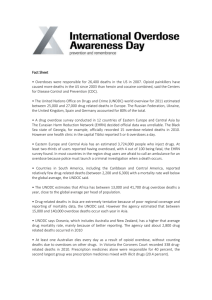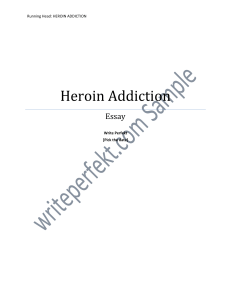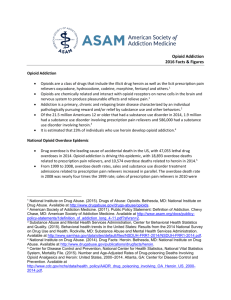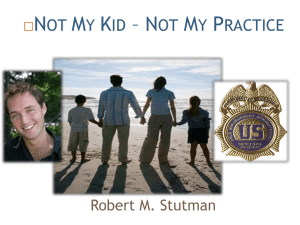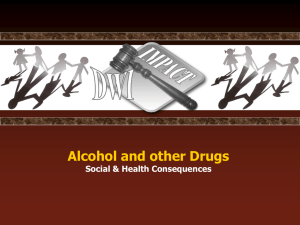The Addiction Crisis
advertisement
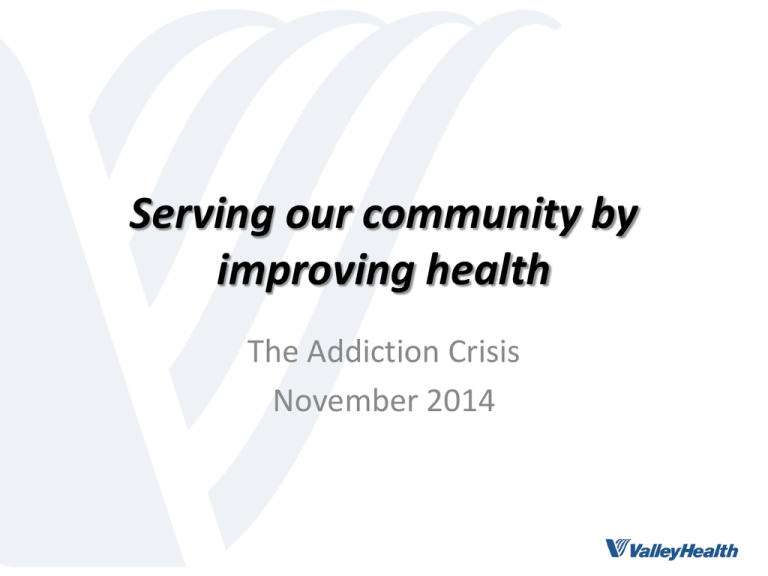
Serving our community by improving health The Addiction Crisis November 2014 The Disease of Addiction – Primary Chronic Disease of Brain Reward, Motivation, Memory and Related Circuitry. – A neurobiological disease that changes how brain cells organize to process information and mediate behavior. Valley Health Data Overview • 5-10x increase in heroin ODs in Valley Health EDs since 2010 • 3x increase in substance exposed newborns at WMC since 2010 • VHS heroin poisoning patients: – 91.1% Caucasian – 75.2 % male – 48.3 % <25 YO Opiate Overdose Deaths NW Virginia 30 25 20 15 10 5 0 2011 2012 2013 2014 * Without the use of NARCAN (A drug used to immediately counteract the effects of Opiates) the death toll would be much higher. Commonly Abused Medications • OPIOIDS: Derived from the opium poppy, or synthetic versions of it, and used for pain relief. • BENEZODIAZEPINES: Central nervous system depressants used as sedatives, to induce sleep, prevent seizures, and relieve anxiety. • AMPHETAMINE LIKE DRUGS: Central nervous system stimulants used to treat Attention Deficit Hyperactivity Disorder (ADHD). Quick Facts • Prescription Drug Abuse has always been around: “Grand Daddy Of All Drug Abuse”. • Is the Nation’s fastest growing drug problem and has been classified as an epidemic. • In 2011, 41,340 unintentional drug overdose deaths occurred in the United States, increase for 12th consecutive year; one person dies every 12.45 minutes1. 22,810 (55%) were prescription drug overdose deaths, of which opioid pain relievers were involved in 16,917 deaths (74.165 %)1. • Opioid pain relievers were involved in more overdose deaths than cocaine and heroin combined1. • Enough prescription pain relievers were prescribed in 2012 to provide every American adult with a bottle of pills1. 1SOURCE: CDC National Center for Health Statistics/National Vital Statistics Report; June 2014 CDC Vital Signs: Opioid Painkiller Prescribing; July 2014 6 Circle of Addiction Oxycodone (Percocet®, Percodan®, Roxicodone®) Hydrocodone OxyContin® OPANA® ZohydroTM ER (Vicodin®, Lortab,® Lorcet®) Heroin 7 Drug Poisoning Deaths Involving Opioid Analgesics, Cocaine, and Heroin: United States, 1999-2011 % CHANGE 2006-11 18,000 16,000 + 23% Number of Deaths 14,000 12,000 10,000 8,000 6,000 - 37% 4,000 + 110% 2,000 - 1999 2000 2001 2002 2003 2004 Opioid analgesic 4,030 Cocaine 3,822 4,400 5,528 7,456 8,517 9,857 10,928 13,723 14,408 14,800 15,597 16,651 16,917 3,544 3,833 4,599 5,199 5,443 6,208 7,448 6,512 5,129 4,350 4,183 4,681 Heroin 1,843 1,784 2,092 2,084 1,879 2,010 2,089 2,402 3,041 3,278 3,036 4,397 1,963 2005 2006 2007 2008 Note: Not all drug poisoning deaths specify the drug(s) involved, and a death may involve more than one specific substance. The rise in 2005-2006 in opioid deaths is related to non-pharmaceutical fentanyl (see http://www.cdc.gov/mmwr/preview/mmwrhtml/mm5729a.htm). *Heroin includes opium. Source: National Center for Heath Statistics/CDC/ National Vital Statistics Report, Final death data for each calendar year (June 2014). 2009 2010 2011 Addiction Select Initiatives • Launched a system-wide Emergency Department Pain Treatment Guidelines June 2014 • Enhancing our philosophy around pain management • Educating our staff and medical staff on best practices • Educating our patients and clients on safe medication management • CME Dinner “Prescription Drug Abuse Crisis” attended by >200 providers • VH Wide monthly Employee Education- Addiction Awareness Addiction Select Initiatives • Educational outreach on substance abuse and addiction • Successfully partnered to expand/market prescription drug “take back” programs • Increased data sharing to support regional grant applications Addiction Select Initiatives • Collaborating with community partners to: • develop a comprehensive, sustainable and effective addiction treatment model • to address this growing public health issue through prevention, education and treatment Serving our community by improving health The Addiction Crisis November, 2014





